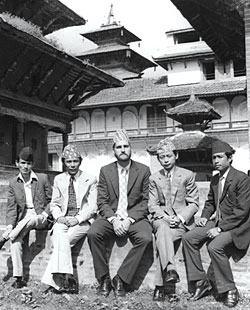 Professor Jim Fisher and Fulbright Scholar in Residence Dr. Navin Rai at Carleton College, 1987 |
2011 marks the 50th anniversary of the Bilateral Agreement. Over the years, the Commission became better known as the United States Education Foundation in Nepal (USEF), or the Fulbright Commission. Funded by the US Congress, its stated mission is to promote "mutual understanding between the peoples of the United States of America and Nepal by a wider exchange of knowledge and professional talents through educational activities."
I recently met with former Education Minister Thapa at his home in Gairidhara. Still vigorous and engaged at 84, he had fond memories of the early 1960s, when Nepal had just begun to march upon the world stage. At the same time, the Government of Nepal also invited the American Peace Corps to start a program in Nepal. While at the UN, Thapa had witnessed the beginnings of John F. Kennedy's presidential campaign and had been impressed by his energy and vision. The establishment of USEF and the Peace Corps, Thapa told me, seemed to offer opportunities to both share that energy, and to open Nepal up to the world in new ways.
 USEF Staff at Hanuman Dhoka 1975: L-R Haribol Thapa, Dipak Mathema, former Director Gabriel Campbell, S.B. Subba and Shyam Shrestha |
The scholarship programs include the flagship Fulbright and Humphrey Fellowship programs and the East-West Center programs of the University of Hawai'i, offered to Nepalis for the pursuit of post-graduate education, post-doctoral research, or teaching in the US. In recent years, USEF's scholarship study opportunities have been further expanded to allow Nepali students to pursue undergraduate study in the US through the PLUS and NESA UGRAD programs.
I served as Executive Director of USEF from 1998 to 2005. My favourite part of the job was contacting the Nepali students and scholars nominated by the Fulbright Commission board to inform them of their selection as Fulbright Scholars or Humphrey Fellows. Once I reached a young woman by phone who was so overcome by emotion at the news that she fainted. I thought the line had gone dead until her mother picked up the phone and asked me to call back later, after her daughter came to her senses.
Why are these programs considered so prestigious and what have they meant for Nepal? To win a Fulbright, Humphrey or East-West Center grant means that one has survived a rigorous, nationwide application process and entered an elite international group of students, scholars, journalists, artists and other professionals. Nepalis who apply for grants through USEF can be confident that the selection process will be strictly merit-based. Perhaps it is for this reason that some referred to USEF as the Asha Kendra. USEF scholarships provide a fully funded educational opportunity at the best American colleges and universities. What people choose to make of that opportunity is entirely up to them.
 Graduates of USEF's PLUS scholarship program in 2010. L-R Moksheda Thapa, Raju Kandel, John Narayan Parajuli, Program Officer Ajaya Shrestha, Ramesh Deshar, Safala Shrestha and Nirmal Gyawali. |
USEF's second core activity � which has arguably had an even wider impact � is its Educational Advising Center (EAC). For 50 years now, the EAC has provided Nepali students with free, accurate and unbiased information on studying in the United States. Currently, at least 10,000 Nepali students use the EAC's resources annually. The EAC's library contains comprehensive resources to assist a student's search for US colleges and universities, scholarship information, as well as free Internet access. USEF is also the only test centre in Nepal for GRE, GED, and USMLE. Despite the proliferation of 'education consultancies' in Kathmandu, USEF remains the most objective and reliable source of information about educational opportunities in the US.
 |
Fulbright and Nobel
The list of Fulbright scholars includes such American and international figures and leaders as Craig Barrett, former Chairman of the Board of Intel Corporation, Derek Bok, former President of Harvard University, John Atta Mills, former president of Ghana, and Javier Solana, EU High Representative for Foreign Policy. Fulbright artists, actors and writers include John Steinbeck, Aaron Copland, Chuck Close, John Lithgow and John Updike. Nobel laureates such as former World Bank chief economist Joseph Stiglitz and Muhammad Yunus, Bangladeshi economist and Grameen Bank founder were Fulbright scholars, too. In fact, more Fulbright alumni have won Nobel Prizes � 43 so far, including two in 2010 � than those of any other academic program, making a Fulbright one of the most reliable 'predictors' of an eventual Nobel Prize.
Who's Fulbright?
 Senator J. William Fulbright |


